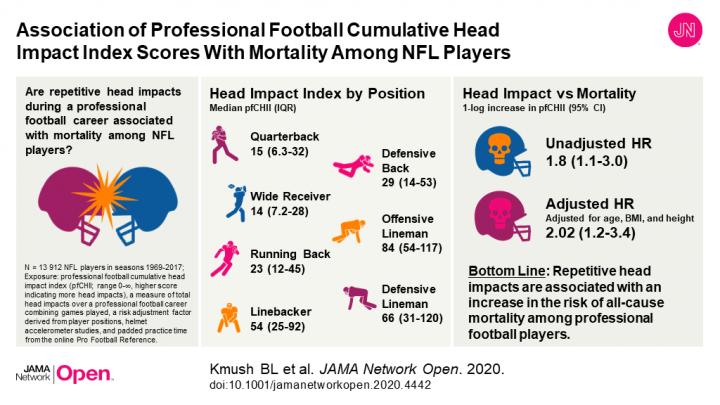
Credit: JAMA Network Open
A new study published Monday in the Journal of the American Medical Association (JAMA) by researchers from the David B. Falk College of Sport and Human Dynamics at Syracuse University shows that an increase in repetitive head impacts for NFL players leads to an increased risk of premature death.
Recent national attention has focused on the long-term effects of concussions on NFL players, including chronic traumatic encephalopathy (CTE). But repetitive head impacts that do not result in concussions can also lead to CTE and premature death, the study shows.
Led by Brittany Kmush, Ph.D., an assistant professor of public health at Syracuse University, the research team studied nearly 14,000 NFL players from 1969-2017 and created a cumulative head impact index determined by combining padded practice time and games played as reported in Pro Football Reference.
“We wanted to see if there was an association between repetitive head impacts and mortality among professional football players,” Kmush said. “We found that increasing head impacts, not just concussions, increased the risk for mortality among NFL players.”
The article “Association of Professional Football Cumulative Head Impact Index Scores With All-Cause Mortality Among National Football League Players” was published today as part of the JAMA Network Open, a monthly open access medical journal covering all aspects of the biomedical sciences.
To account for a player’s position, the researchers used a player position risk adjustment based on helmet accelerometer studies developed by Boston University’s Alzheimer’s Disease and CTE Center at the Boston University School of Medicine. The study adjusted for birth year, body mass index and height, and it did not include special teams’ players because there was no data for that group of players.
The research suggests that the continued application of rule and equipment changes that minimize repetitive head impacts will lower the mortality risk.
“NFL players are a highly selected group of people; we need future studies to focus on the effects of head impacts on youth, high school, and college football players as well as expand this research into other sports and activities,” Kmush said. “Our goal is to make sports safer.”
###
The Syracuse University team included Kmush, public health Master’s student Madeline Mackowski, Sport Management assistant professor Justin Ehrlich, Public Health assistant professor Bhavneet Walia, Public Health/Applied Statistics professor Arthur Owora, and Sport Management associate professor Shane Sanders.
Media Contact
Matthew Michael
[email protected]




